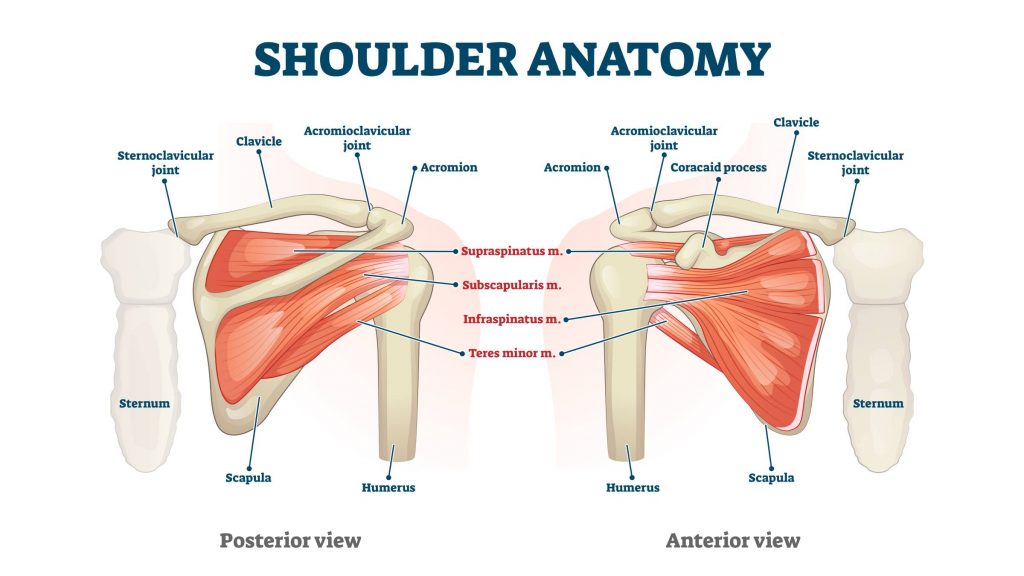If you’ve ever had shoulder pain, put your hand high up in the air.
You can lift your arm way over your head because your shoulder is the most moveable joint in your body. Its closest rival is your hip joint but it’s not really a contest – try to swing your hip in a full circle and see for yourself.
As mobility in a joint increases, stability decreases and that means your body has to work harder to keep the very mobile shoulder joint strong and healthy. Our skulls have some of the least mobile joints in our bodies and I’ve never heard of someone with a skull dislocation but shoulder dislocations are common injuries.

The mechanics of the shoulder
The shoulder is a ball-and-socket joint and derives its name from the ball on the top of the long bone in your arm that fits into the shoulder blade which acts as a socket, albeit a very shallow socket. The shallow socket allows for a lot of movement but not a lot of support. Stabilization then is very important and must be performed by muscles and ligaments. The four rotator cuff muscles are responsible not only for stabilizing the joint but for modifying its movement. There is a second joint involved in the shoulder which occurs between the shoulder blade and your collar bone above the ball-and-socket joint. This acromioclavicular joint helps the larger joint below to move through its full range, particularly when you’re raising your arm, lifting or throwing.
With all this complex architecture involved there are quite a few things that can become compromised and cause shoulder pain.
Some of the common causes of shoulder pain are:
- Arthritis,
- AC joint sprains (acromioclavicular)
- Bony spurs,
- Bursitis – Inflammation of the bursa (a fluid filled sac within the joint),
- Broken bones,
- Dislocations,
- Frozen shoulder
- Overuse injuries,
- Neck problems,
- Tears or inflammation of rotator cuff muscles or tendons,
- Poor shoulder posture and mechanics with ‘rounded shoulders’.

Where does shoulder pain come from?
It’s possible the pain you’re feeling in your shoulder is coming from a problem in another part of your body, such as your neck or even your lower back. Inflammation of the muscles or tendons of the rotator cuff, however, is the most common cause of shoulder pain that Chiropractors see in practice every day. This is closely linked to your posture and on the nerves that exit your neck and control the joint.
Postural issues can create shoulder pain because of how our bodies compensate. As our bodies respond to physical, emotional, and chemical stressors and cause our heads to drop forward, our shoulders curl forward and we start to hunch. This results in a series of different problems:
- The increased stress on your neck not only causes muscle pain in the area but can refer pain into your shoulder. Changed neck mechanics also causes interference with the nerves that are vital to control and protect your shoulder joints.
- The way that your shoulder muscles work has to change and it causes them to have to compensate in strange ways and produce much more force than what they’re built for.
- It causes the arm bone to butt up against the bones of the higher joint and cause friction on the tendons of the rotator cuff and biceps muscles – resulting in attrition of the tendons and swelling in the bursa.
Poor posture is essentially a perfect storm for shoulder problems. Learn more about posture here.
Does Chiropractic care help with shoulder pain?
When assessing a person presenting with shoulder pain, a vitalistic Chiropractor will ensure that they don’t forget about the importance of posture and the whole body in the process. An Advanced BioStructural Correction™ Chiropractor address the bones of your spine that have moved forward, resulting in the forward hunched posture. By correcting what the body can’t self-correct, you’re then able to get your shoulders back into a healthy position where they’re designed to work at their very best thus aiding the healing process.
To find out more about Chiropractic care, watch this short video.
Peak Chiropractic Centre located in Claremont are family-friendly chiropractors focused on relieving aches, pains and posture correction. We offer in-house X-Ray facilities.


